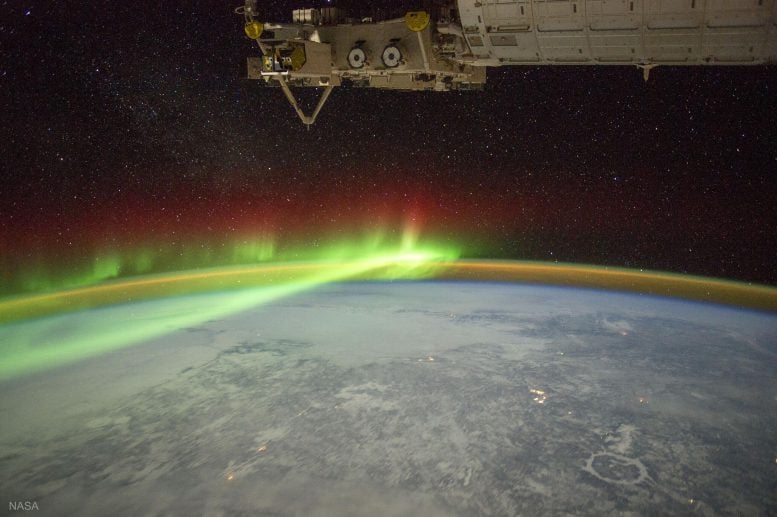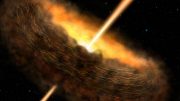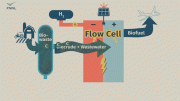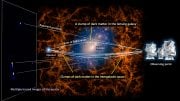ICON provided groundbreaking insights into the ionosphere, revealing how it interacts with terrestrial and space weather. Its findings on plasma motion and the ionospheric dynamo have reshaped our understanding of this atmospheric layer’s influence on technology and communication. Credit: NASA’s Goddard Space Flight Center/Mary Pat Hrybyk-Keith
NASA’s ICON mission enhanced our understanding of the ionosphere’s impact on technology by studying its interactions with Earth and space weather, setting the stage for ongoing scientific exploration.
- NASA’s ICON mission studied the outermost layer of Earth’s atmosphere called the ionosphere.
- ICON provided critical insights into interplay between space weather and Earth’s weather. The mission gathered unprecedented detail of airglow, showed a relationship between the atmosphere’s ions and Earth’s magnetic field lines, and provided the first concrete observation to confirm Earth’s long-theorized ionospheric dynamo.
- Nearly a year after ICON accomplished its primary mission, communication was lost in November 2022 for unclear reasons. NASA formally concluded the mission after several months of troubleshooting could not regain contact.
Mission Overview
After contributing to many important findings on the boundary between Earth’s atmosphere and space — an area where space weather can interfere with both satellites and communications signals — NASA’s ICON (Ionospheric Connection Explorer) mission has come to an end. The mission launched in October 2019 and completed its two-year mission objectives in December 2021, before going on to operate as an extended mission for another year.
“The ICON mission has truly lived up to its name,” said Joseph Westlake, heliophysics division director at NASA Headquarters in Washington. “Not only did ICON successfully complete and exceed its primary mission objectives, it also provided critical insights into the ionosphere and the interplay between space and terrestrial weather.”
Ionospheric Investigations
The ICON spacecraft orbited in a part of our planet’s outermost layer of the atmosphere, called the ionosphere, where it studied what events impact the ionosphere, including Earth’s weather from below and space weather from above. The ionosphere is the lowest boundary of space, located between 55 miles to 360 miles above Earth’s surface. It is made up of a sea of particles that have been ionized: a mix of positively charged ions and negatively charged electrons called plasma.
This frontier of space is a dynamic and busy region, home to many satellites — including the International Space Station — and is a conduit for radio communications and GPS signals. Both satellites and signals can be disrupted by the complex interactions of terrestrial and space weather, so studying and understanding the ionosphere is crucial to understanding space weather and its effects on our technology.
Video explaining the features of the ionosphere, Earth’s outmost layer of the atmosphere. It is home to the aurora, the International Space Station, a variety of satellites, and radio communication waves. Credit: NASA/Goddard/Conceptual Image Lab/Krystofer Kim
Groundbreaking Data and Discoveries
The ICON mission captured unprecedented data about the ionosphere with direct measurements of the charged gas in its immediate surroundings alongside images of one of the ionosphere’s most stunning features — airglow.
ICON tracked the colorful bands as they moved through the ionosphere. Airglow is created by a process similar to what creates the aurora. However, airglow occurs around the world, not just at the northern and southern latitudes where auroras are typically found. Although airglow is normally dim, ICON’s instruments were specially designed to capture even the faintest glow in order to build a picture of the ionosphere’s density, composition, and structure.
By measuring Doppler shift, ICON’s sensitive imagers also detected the motion of the atmosphere as it glowed. “It’s like measuring a train’s speed by detecting the change in the pitch of its horn — but with light,” said Thomas Immel, ICON mission lead at the University of California, Berkeley. The mission was specifically designed to perform this technically difficult measurement.
Enhanced Scientific Understanding
The ICON mission’s comprehensive view of the upper atmosphere provided valuable data for scientists to unravel for years to come. For instance, its measurements showed how the 2022 Hunga Tonga-Hunga Ha’apai volcanic eruption disrupted electrical currents in the ionosphere.
“ICON was able to capture the speed of the volcanic eruption, allowing us to directly see how it affected the motion of charged particles in the ionosphere,” Immel said. “This was a clear example of the connection between tropical weather and ionospheric structure. ICON showed us how things that happen in terrestrial weather have a direct correlation with events in space.”
Technological and Scientific Advances
Another scientific breakthrough was ICON’s measurements of the motion of ions in the atmosphere and their relationship with Earth’s magnetic field lines. “It was truly unique,” Immel said. “ICON’s measurements of the motion of ions in the atmosphere was scientifically transformational in our understanding of behavior in the ionosphere.”
With ICON’s help, scientists better understand how these interactions drive a process called the ionospheric dynamo. The dynamo, which lies at the bottom of the ionosphere, remained a mystery for decades because it is difficult to observe.
ICON provided the first concrete observation of winds fueling the dynamo and how this influences space weather. Unpredictable terrestrial winds move plasma around the ionosphere, sending the charged particles shooting out into space or plummeting toward Earth. This electrically charged tug-of-war between the ionosphere and Earth’s electromagnetic fields acts as a generator, creating complex electric and magnetic fields that can affect both technology and the ionosphere itself.
“No one had ever seen this before,” Immel said. “ICON finally and conclusively provided experimental confirmation of the wind dynamo theory.”
Mission Conclusion and Legacy
On November 25, 2022, the ICON team lost contact with the spacecraft. Communication with the spacecraft could not be established, even after performing a power cycle reset using a built-in command loss timer. Though the spacecraft remains intact, other troubleshooting techniques were unable to re-establish contact between the ICON spacecraft and mission operators.
“ICON’s legacy will live on through the breakthrough knowledge it provided while it was active and the vast dataset from its observations that will continue to yield new science,” Westlake said. “ICON serves as a foundation for new missions to come.”










Be the first to comment on "ICON’s Legacy: Transforming Our Understanding of the Ionosphere"